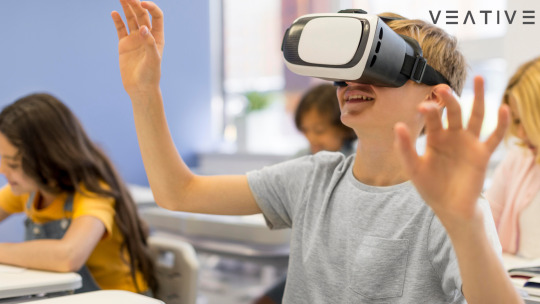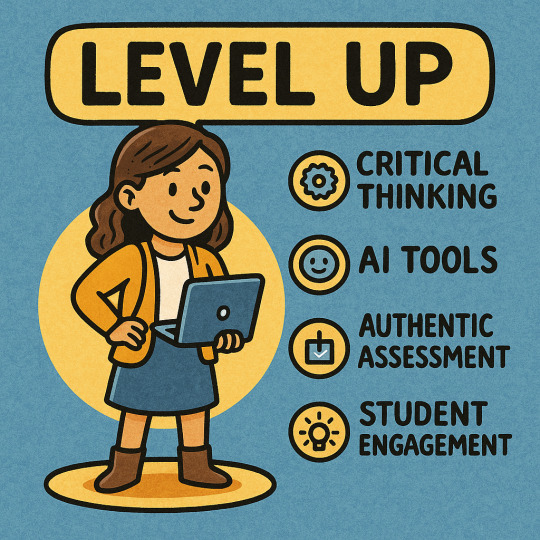#Education Technology (EdTech)
Explore tagged Tumblr posts
Text
Are you an EdTech enthusiast? 🌟
Dive into our latest blog where we describe the difference between Augmented Reality (AR) and Virtual Reality (VR)! Discover how these cutting-edge technologies are revolutionizing industries by providing unique experience.
👉 Click the link to read more and expand your tech knowledge: https://fotonvr.com/ar-vs-vr/
#EdTech #ARvsVR #Technology #Education #Innovation
3 notes
·
View notes
Photo



(via Virtual Revolution: How Education Will Transform by 2030)
2 notes
·
View notes
Text
5 Benefits of using Virtual Reality in Education Driving Future of EdTech
So, you want to know how virtual reality is driving the future of EdTech? Well, you're in the right place. Virtual reality is an exciting technology that is revolutionizing the way we learn and interact with the world around us. It combines computer-generated images and sounds to create an immersive experience that can transport you to another world—or even another time.
Edtech, on the other hand, is a broad term that encompasses any technology that is used to enhance learning. From online courses to educational apps, Edtech is changing the way we think about education. In this blog, we're going to explore the benefits of using virtual reality in education. We'll also look at some examples of virtual reality in action and discuss the future of EdTech. So buckle up and get ready to explore the exciting world of virtual reality and EdTech!

What is Virtual Reality and Edtech?
Virtual reality and edtech are two buzzwords that have been making the rounds in the education industry lately. But what exactly are they, and how are they related?
Virtual reality (VR) is a technology that creates a digital environment that simulates physical reality. In education, this means students can explore different worlds and experiences in a safe, controlled, and engaging way. On the other hand, edtech is an umbrella term that refers to the use of technology to enhance teaching and learning. This can include everything from online classes and digital textbooks to educational apps, games, and simulations.
When you combine VR and edtech, you get a powerful tool that has a lot of potential to transform education. Imagine being able to teleport your students to different countries, eras, or even inside the human body. With VR, the possibilities are endless.
However, there are also some challenges that come with implementing VR in education. One of the biggest is the cost of the technology and the training required to use it effectively. Another challenge is ensuring that the content is aligned with the curriculum and that the learning objectives are clear.
Despite these challenges, there is no denying the potential of VR in education. As technology continues to improve and more resources become available, we can expect to see even more innovative ways of using VR and edtech to enhance teaching and learning.
5 Benefits of Using Virtual Reality in Education
Virtual reality (VR) has become a hot trend in the education sector these days. With technological advancements, educators have found numerous ways to incorporate VR into teaching and learning. VR is appealing to both students and teachers, making it an effective tool for education. In this blog, we will discuss the benefits of using virtual reality in education.
Firstly, VR increases student engagement and retention. Children tend to learn more effectively if they are entertained and involved. VR provides an immersive learning experience, capturing the students’ attention and allowing them to learn in unique ways. Such a learning method creates long-lasting impressions in the minds of the pupils.
Secondly, VR enhances experiential learning. Students can experience a wide array of learning scenarios that may not be possible in real life. Thus, irrespective of the subject or field, VR allows learners to apply their knowledge and develop new skills in a risk-free environment. The benefits of experiential learning include active participation, better retention, and practical application of knowledge.
Thirdly, VR encourages collaboration and teamwork. Students can work together in a virtual environment just as they would in a real setting. They can exchange ideas, solve problems together, and work on group projects. By doing so, they can learn to value teamwork and develop essential communication, leadership, and problem-solving skills.
Fourthly, VR provides customized learning experiences. Different students have unique learning styles and assimilate knowledge differently. With VR, an educator can design a personalized learning experience to suit each individual's needs. This allows learners to learn optimally and at their own pace, taking into account their challenges, preferences, and strengths.
Lastly, VR offers cost-effective solutions. Traditional methods of learning may be expensive, time-consuming, and, at times, risky. Compared to the heavy investments that may be needed for physical classrooms, VR can provide similar results at a more affordable cost. Also, it offers flexibility, and learners can access learning material anywhere and anytime.
These benefits make VR an attractive tool for modern-day teaching and learning methods. As AR and VR tech continue to evolve, VR will only become more critical to the education industry, creating better outcomes for learners and educators globally.
Examples of Virtual Reality in Education
Virtual reality (VR) has transformed education by providing immersive learning experiences beyond the boundaries of physical classrooms. The VR applications benefit students by enhancing their experiential learning, increasing engagement and retention, and encouraging collaboration and teamwork in real-time.
As such, edtech developers are investing more time and resources into meeting the demand for VR. The future of edtech and VR is likely to see increased demand, personalized learning experiences, and education beyond traditional classroom settings.
Future of Edtech and Virtual Reality
As technology continues to evolve and transform various industries, the future of edtech and virtual reality seems promising. The increased demand and investment in this sector is a testament to the potential benefits that virtual reality can bring to education.
One of the most exciting prospects of edtech and virtual reality is personalized learning, where students can tailor their educational experiences to their individual needs and preferences. This could revolutionize the way we approach education, making it more engaging and effective.
Furthermore, virtual reality offers endless opportunities for exploration beyond traditional learning settings. Students can explore historical landmarks, visit other countries, and even travel to outer space, all without leaving their classroom. This opens up a whole new world of learning and discovery that was once unimaginable.
Overall, the future of edtech and virtual reality in education is exciting, and the potential for innovation and growth is vast.
Conclusion
In a world where technology is rapidly evolving, virtual reality (VR) plays a vital role in shaping the future of education. By providing engaging and immersive experiences, VR technology has completely transformed the way educators teach and students learn. Some of the benefits of using VR in education include increases in student engagement and retention, enhanced experiential learning, encouraging teamwork, customized learning experiences, and cost-effective solutions. With VR becoming increasingly popular in education, it's essential for students, teachers, and institutions to embrace this technology to drive the future of EdTech.
3 notes
·
View notes
Text
AI Tools to Boost Your Learning Experience Across the USA
Explore the top AI tools for Learning education in the USA with personalized learning, smart tutoring, and productivity enhancements for students. Artificial Intelligence is reshaping how students in the USA approach education by offering smarter, faster, and more personalized learning tools. With intelligent platforms and real-time analysis, learners can now achieve their academic goals more…
#AIinEducation#AIStudents#EdTech#LearningToolsUSA#SmartStudy#ai#AI Education Tools#artificial-intelligence#education#learning with AI#teaching#technology#USA Students
0 notes
Text
🚨 Assessment is evolving — are we keeping up? Generative AI tools like ChatGPT aren’t going away. So instead of banning them, what if we redesigned how we assess learning? 👉 I just published a new piece on how Aotearoa’s tertiary sector can shift from policing AI use to purposeful integration. We’re talking critical thinking, process-over-product, and future-ready assessment strategies. 💬 Educators, designers, disruptors — what’s your take? How are YOU adapting? 🔗 Read it here: [insert blog URL] 📘 And if you want the deep dive → Education is Over. Adapt or Die #AIinEducation #AssessmentDesign #EdTech #HigherEd #FutureOfLearning #EducationIsOver

View On WordPress
#academic integrity#AI in education#AI literacy#AI Tools in Teaching#AIHOA#Ako Aotearoa#assessment design#authentic assessment#ChatGPT#collaborative learning#Critical Thinking#digital pedagogy#Edtech#Education Technology#Future of Learning#Generative AI#Graeme Smith#Higher education#learning design#process over product#Reflective Practice#teacher strategies#tertiary assessment
0 notes
Text
10 Powerful Benefits of Outsourcing Back Office Services to Accelerate Business Growth
In a fast-paced and increasingly digital business environment, companies are under constant pressure to optimize resources, reduce operational overhead, and sharpen their competitive edge. One of the most effective ways to achieve these objectives is through the strategic outsourcing of back-office services. These services—though not customer-facing, are the structural backbone of daily operations, encompassing everything from data management and finance to IT support and HR administration.
Outsourcing these functions offers significant advantages that extend far beyond mere cost reduction. Here are the top 10 benefits that make outsourcing back office services a strategic imperative for forward-thinking businesses.
1. Substantial Cost Efficiency
Outsourcing helps businesses avoid the financial burdens associated with hiring, training, and maintaining full-time in-house staff. Operational expenses such as infrastructure, utilities, software licensing, and employee benefits are also minimized. Vendors offering back office services often operate in cost-effective regions, allowing organizations to take advantage of favorable labor markets without compromising service quality.
2. Enhanced Focus on Core Competencies
Outsourcing non-core functions allows companies to channel internal resources and managerial bandwidth toward high-value strategic activities. While third-party experts handle complex back office services, leadership teams can dedicate more attention to innovation, product development, and customer engagement—areas that directly impact long-term growth.
3. Access to Global Talent Pools
Outsourcing opens the door to a diverse array of highly skilled professionals who specialize in various back office services such as accounting, compliance, data processing, and IT administration. This access to global expertise eliminates the need to compete for limited local talent, while ensuring service excellence and consistency across the board.
4. Operational Scalability
Business growth is rarely linear. As companies scale, so do their administrative and operational demands. Outsourcing provides a flexible framework that allows organizations to ramp up or down their back office services based on seasonal demand, project timelines, or market conditions—without the delays or risks associated with internal hiring cycles.
5. Improved Turnaround Time
With teams working across multiple time zones, outsourced back office services often result in 24/7 productivity. Tasks assigned at the close of one business day can be completed by an offshore team overnight, leading to faster turnaround times and an agile response to operational needs. This time-zone advantage is particularly valuable for businesses managing large volumes of data or time-sensitive tasks.
6. Technological Edge Without the Investment
Many outsourcing providers utilize advanced technologies such as AI-driven analytics, robotic process automation (RPA), and cloud platforms to streamline their back office services. Partnering with such providers allows businesses to leverage cutting-edge tools and infrastructure without incurring capital expenditures. This results in better efficiency, higher accuracy, and lower error rates.
7. Regulatory Compliance and Risk Management
Navigating legal regulations and industry standards can be complex and time-consuming. Reputable outsourcing providers have a thorough understanding of compliance requirements across various jurisdictions. From data security to financial regulations, their expertise in delivering compliant back office services helps mitigate operational risks and avoid costly penalties.
8. Consistent Service Quality
Through well-defined service level agreements (SLAs), regular performance audits, and robust quality assurance mechanisms, outsourcing ensures consistency and accuracy in service delivery. Providers are contractually bound to maintain certain standards, which translates into reliable and measurable outcomes across all back office services.
9. Streamlined Business Continuity
Outsourcing providers often operate with built-in redundancies, backup systems, and disaster recovery protocols. This ensures uninterrupted delivery of back office services even during crises, whether they stem from natural disasters, cyberattacks, or other disruptions. Maintaining continuity is critical for businesses seeking to preserve stakeholder trust and regulatory compliance.
10. Accelerated Digital Transformation
Outsourcing facilitates rapid adoption of digital practices and automation. With specialists at the helm of back office services, businesses can digitize and modernize legacy systems faster and more effectively. This not only enhances operational resilience but also sets the foundation for future innovation and scalability.
Outsourcing back office services is no longer a transactional decision driven solely by cost. It is a transformative strategy that fuels efficiency, agility, and growth. As market demands evolve and operational complexity increases, businesses that embrace this model are better positioned to compete, innovate, and thrive in the global marketplace.
0 notes
Text
📲 Apps para organizar tu vida (y tener tiempo para ti)
En medio del caos diario, las responsabilidades laborales, los compromisos personales y la sensación de que el día no tiene suficientes horas… una verdad se vuelve clara: necesitamos ayuda para recuperar el control de nuestro tiempo y, sobre todo, para priorizarnos a nosotros mismos. La buena noticia es que ya no tienes que hacerlo sola o solo. Hoy te presento una selección curada de apps…
0 notes
Text
AI Dolls and Digital Desks: High School Teaching in 2025
An article by Richard James Rogers (Award-Winning Author of The Quick Guide to Classroom Management and The Power of Praise: Empowering Students Through Positive Feedback). This blog post is illustrated by Pop Sutthiya Lertyongphati. Don’t forget to check out the full bibliography and recommended reading list at the end of this blog post. Artificial Intelligence (AI) used to sound like science…
#Academic Integrity#AI action figure#AI and learning#AI avatar#AI Barbie#AI co-pilot#AI doll trend#AI in education#AI in the classroom#AI tools for teachers#AIDoll#AIDollTrend#Artificial Intelligence#BarbieBoxChallenge#Barbiecore#ChatGPT doll#ChatGPT in schools#classroom technology#creative writing tools#Critical Thinking#differentiated learning#Digital Literacy#edtech#education#education trends 2025#educational innovation#ethical AI use#future of education#generative AI#high school teaching
0 notes
Text
AI and Theatre Integration
The New Stage: Digital Innovations in Theatre Production Theatre has always been a reflection of human creativity and storytelling. From the grand spectacles of Ancient Greece to the intricate stagecraft of the Renaissance, innovation has altered, modified and affected performing arts forward, and encouraged it to adapt to new ways. Today, technology is revolutionizing theatre once again.…
#alternative education#children&039;s theatre#drama education#drama journal#edtech#education#News#technology
0 notes
Text
The Metaverse is transforming education by enabling immersive, interactive, and engaging learning experiences. Simulanis, a leader in AR, VR, MR, and Metaverse solutions, is at the forefront of this revolution, developing cutting-edge��immersive learning technologies for various industries.
#Metaverse education#VR learning solutions#Simulanis Metaverse#Virtual classrooms#Immersive learning#VR training for students#Augmented reality education#AI in education#Gamification in learning#Industrial training in VR#Virtual reality for schools#Metaverse training simulations#Experiential learning technology#Digital twins in education#Simulanis VR training#AI-powered education#Remote learning with VR#Blockchain in education#Future of e-learning#VR medical training#Augmented reality classrooms#Virtual skills development#Metaverse for corporate training#EdTech Metaverse solutions#Interactive learning environments#VR language learning#Simulanis AR VR solutions#Metaverse-based e-learning#Haptic feedback in education#Next-gen education technology
0 notes
Text





A New Era of Learning Begins! 🚀 fotonVR is excited to share that we have completed another successful #fotonVR lab setup in a school. 🎓 Students are now stepping into a world of immersive, hands-on learning through cutting-edge #virtualreality technology. At fotonVR, our mission is to transform #education by bringing innovative VR experiences to classrooms, empowering students to learn in new, engaging ways. 🌟 . Ready to bring the future of learning to your school? Contact us today to get started! 🚀 https://fotonvr.com/contact-us
0 notes
Text
Reality is Dead, Long Live Reality!
On Art, Education, and the Current State of Everything MARCH 3, 2025 By Nicholas Andriani I woke up today with a question rattling in my head like a loose screw in the machinery of modern life: What does it mean to create in an era of collapsing reality? Everywhere I turn, the fractures are widening. The things we once called truth, fact, or even just a shared reality are dissolving under the…
#Arab spring#author#Backpacking#band#Between the Sun and Us#curriculum design#edtech#education#educational consultant#educational game#educational game design#educational technology#game design#instructional consultant#instructional design#Kansas City#KCMO#memoir#middle east#midwest#music#Podcast#poet#Poetry#punk rock#teaching#travel writer#travel writing#writer
1 note
·
View note
Text
AI-Driven Cybersecurity: Protecting Education from Breaches
By Leon Basin | Alumnus, Santa Clara University Leavey School of Business | Bridging Academic Rigor & Real-World Cybersecurity Executive Summary 2025 Education Cyberattack Snapshot In 2025, 56% of U.S. school districts suffered cyber breaches—many stemming from compromised privileged accounts (K12 SIX). With K-12 breach costs averaging $4.45M per incident (IBM), institutions must act…
#AI-Powered Security#Artificial Intelligence (AI)#Behavioral Analytics#Business Strategy#cybersecurity#Cybersecurity in Education#Education Technology (EdTech)#Higher Consciousness#Insider Threats#Just-in-Time Access (JIT)#K-12 Cybersecurity#Regulatory Compliance#Research Data Security#Zero Trust
0 notes
Text
The Role of AI in Modern Education
Explore how AI in modern education is transforming classrooms, personalizing learning, and helping students thrive in the United States. Artificial intelligence is playing a powerful role in transforming classrooms and learning systems across the United States today.Teachers and students in American schools are experiencing smarter, faster, and more customized education powered by intelligent…
#ai#AI for Students#AI in Education#ai-in-education#Artificial Intelligence#artificial-intelligence#Digital Learning Tools#EdTech in America#education#learning#Modern Learning Tools#Personalized Learning#personalized-learning#Smart Teaching#teaching#technology#USA Classrooms
0 notes
Text
🚀 AI is transforming education for neurodiverse learners! From personalized learning to executive function support, discover how ALEC GPT is breaking barriers for dyslexia, ADHD, and more. Let's build a future where all learners thrive! 🌍✨ How are you using AI to support ND learning? Drop a comment & join the conversation! 👇 #AIforNeurodiversity #InclusiveEducation

View On WordPress
#ADHD learning tools#AI and neurodiversity#AI for accessibility#AI for Literacy#AI for neurodiverse learners#AI in education#AI learning tools#ALEC GPT#assistive technology#Dyslexia Support#EdTech innovation#executive function support#Inclusive Education#neurodiversity in education#Universal Design for Learning
1 note
·
View note
Text
Technological Interventions by NGOs to Support Girl Child Education
Education is a transformative tool, and its significance is even more profound when it comes to empowering young girls. Across the globe, millions of girls face barriers to education due to socio-economic, cultural, and infrastructural challenges. NGOs dedicated to supporting girl child education are playing a pivotal role in addressing these challenges, often leveraging technology to make a greater impact. Among these, Nanhikali stands out as a shining example of an NGO for girl child education, driving change through innovative methods.
The Role of Technology in Bridging Educational Gaps
The integration of technology into educational initiatives has proven to be a game-changer, especially for marginalized communities. Here’s how NGOs are using technological interventions to uplift the education of the girl child:
E-Learning Platforms Many NGOs are developing and implementing e-learning platforms tailored to meet the unique needs of underprivileged girls. These platforms provide access to quality educational content, even in remote areas. For instance, Nanhi Kali’s digital learning program ensures that girls from marginalized communities have access to interactive and engaging educational tools, helping them bridge learning gaps.
EdTech Devices NGOs are distributing tablets, smartphones, and other devices pre-loaded with educational apps and offline content. These devices are equipped with interactive modules, videos, and quizzes to make learning more engaging. This approach ensures that girls can continue their education, even in areas with limited or no internet connectivity.
AI and Personalized Learning Artificial intelligence (AI) is being used to tailor educational content to the individual learning pace and style of each student. Personalized learning ensures that girls who may have missed school or have varying levels of comprehension can catch up without feeling left behind.
Virtual Classrooms Virtual classrooms enable girls in remote locations to attend live classes conducted by qualified teachers. NGOs are partnering with tech companies to provide the necessary infrastructure and ensure a seamless learning experience.
Community Learning Centers NGOs like Nanhikali are setting up community learning centers equipped with digital tools. These centers serve as safe spaces where girls can study, access the internet, and receive mentorship and guidance.
Addressing Broader Challenges with Technology
Technology is not just limited to delivering educational content; it also helps tackle other barriers to education:
Tracking Attendance and Performance: Digital tools allow NGOs to monitor attendance and academic progress, enabling them to provide timely interventions when needed.
Awareness Campaigns: Mobile apps and social media platforms are used to spread awareness about the importance of girl child education, challenging traditional norms and mindsets.
Safety and Support: NGOs are leveraging technology to create platforms where girls can report safety concerns and seek support, fostering an environment that encourages consistent school attendance.
Nanhi Kali: A Beacon of Hope
Established with the vision of empowering underprivileged girls through education, Nanhikali has become synonymous with impactful and sustainable interventions. The organization combines academic support with material assistance to ensure holistic development for girls. Their use of technology, from e-learning tools to robust monitoring systems, ensures that no girl is left behind.
Through partnerships with corporates and communities, Nanhikali has successfully transformed the lives of thousands of girls, helping them break free from the cycle of poverty and discrimination.
The Way Forward
While significant strides have been made, the journey to universal girl child education is far from over. NGOs must continue to innovate and collaborate with technology providers, governments, and local communities to scale their efforts. Initiatives like those by Nanhikali demonstrate that with the right tools and determination, we can create a future where every girl has the opportunity to learn, grow, and thrive.
By supporting an NGO for girl child education, you too can contribute to building a more equitable and empowered world. Together, let’s ensure that technology and education reach every girl, no matter where she is.
0 notes